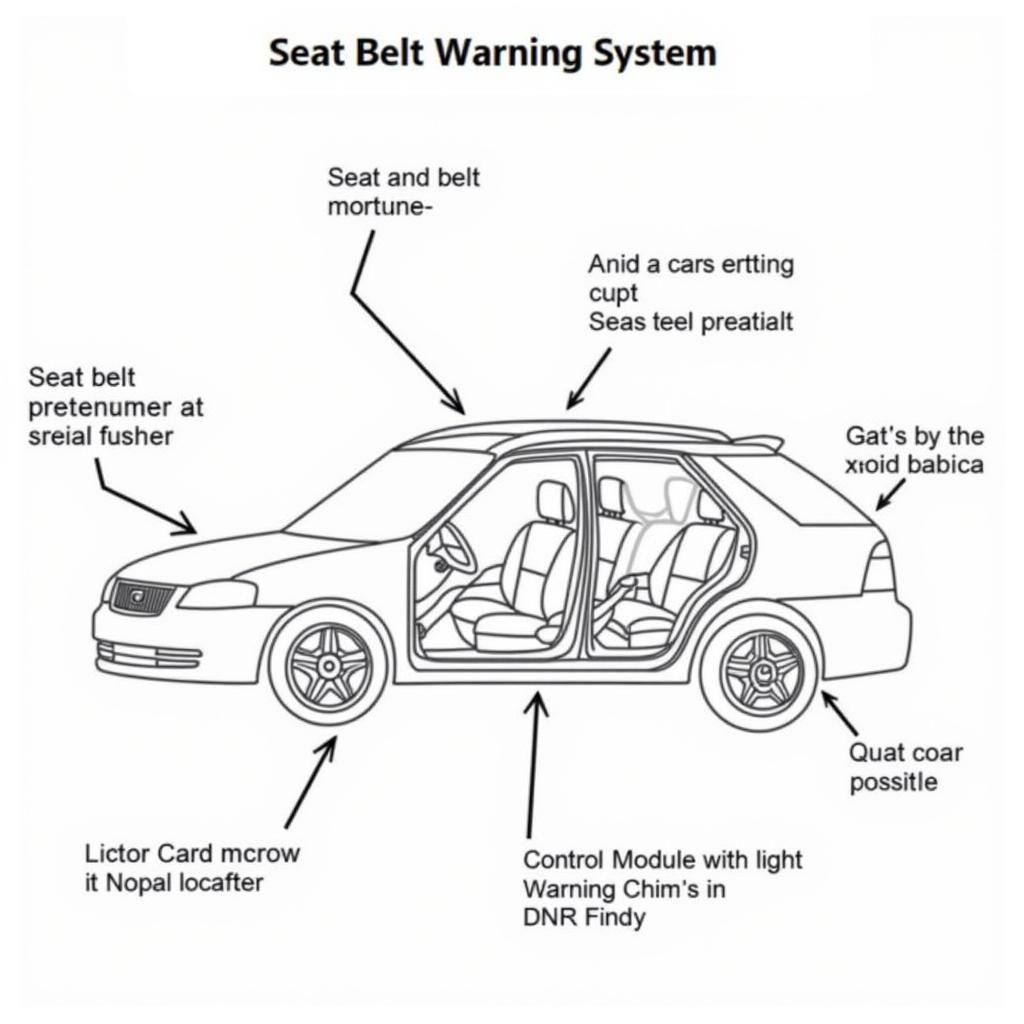The car seat belt warning sound – that persistent chime that fills your car until you buckle up – is a crucial safety feature designed to remind drivers and passengers to wear their seat belts. While it might seem annoying at times, it plays a vital role in accident prevention. This article delves into the intricacies of the car seat belt warning system, exploring its functions, common causes of malfunctions, and practical troubleshooting tips.
Understanding the Seat Belt Warning System
Modern vehicles are equipped with a sophisticated seat belt warning system that consists of several components working in harmony:
- Seat Belt Buckle Sensor: Located within the buckle assembly, this sensor detects whether the seat belt is fastened.
- Seat Belt Pretensioner: In the event of a collision, this device tightens the seat belt to secure the occupant firmly against the seat.
- Control Module: The brain of the system, the control module receives signals from the sensors and triggers the warning chime and light.
- Warning Chime and Light: These serve as audible and visual cues to alert the driver and passengers to fasten their seat belts.
When the ignition is turned on, and a seat belt remains unbuckled, the buckle sensor sends a signal to the control module, which then activates the warning chime and light.
 Car Seat Belt Warning System Components
Car Seat Belt Warning System Components
Common Causes of a Car Seat Belt Warning Sound Malfunction
A malfunctioning seat belt warning system can be a nuisance, often manifesting as a continuous chime or a warning light that won’t turn off. Here are some common culprits:
- Faulty Buckle Sensor: A damaged or malfunctioning buckle sensor may fail to detect a fastened seat belt, leading to a persistent warning.
- Wiring Issues: Damaged or corroded wiring connecting the sensor to the control module can disrupt the signal flow, triggering malfunctions.
- Control Module Problems: A faulty control module can lead to erratic behavior in the warning system, including false alarms or a complete system failure.
- Seat Belt Pretensioner Fault: In some cases, a problem with the seat belt pretensioner can trigger the warning system.
Troubleshooting a Car Seat Belt Warning Sound
Before heading to a mechanic, there are a few troubleshooting steps you can take to identify and potentially resolve the issue:
- Check the Basics: Ensure all seat belts are properly fastened and that there are no objects obstructing the buckle mechanisms.
- Inspect the Buckle: Examine the buckle for any visible damage, debris, or loose connections.
- Check the Wiring: If you’re comfortable working with car electronics, carefully inspect the wiring harness connected to the buckle sensor for any signs of damage or corrosion.
- Consult a Professional: If the problem persists, it’s best to consult a qualified automotive electrician or mechanic who can diagnose the issue using specialized diagnostic tools.
 Mechanic Diagnosing Car Seat Belt Warning System
Mechanic Diagnosing Car Seat Belt Warning System
Why Is My Seat Belt Warning Light On, But There’s No Sound?
In some instances, you may encounter a situation where the seat belt warning light illuminates on the dashboard, but the accompanying chime remains silent. This scenario often suggests a specific type of fault within the warning system. Potential causes include:
- Speaker Issue: The warning chime’s speaker itself may be faulty.
- Wiring Problem: A break in the wiring leading specifically to the speaker can prevent the sound from being produced.
Can I Disable the Car Seat Belt Warning Sound?
While it might be tempting to silence a persistent or malfunctioning warning chime, it’s crucial to remember that seat belts are paramount for safety. Tampering with or disabling the warning system is strongly discouraged and may even be illegal in some jurisdictions.
Advanced Diagnostics and Remote Software Solutions
With advancements in automotive technology, remote diagnostics and software solutions have emerged as valuable tools for addressing car seat belt warning sound issues:
- Remote Diagnostics: Skilled technicians can remotely access a vehicle’s computer system to retrieve diagnostic trouble codes (DTCs) related to the seat belt warning system. This enables them to pinpoint the root cause swiftly.
- Software Updates and Programming: In certain cases, software glitches within the control module can lead to warning system malfunctions. Remote software updates and reprogramming can effectively address such issues.
2010 lexus rx 350 seat belt warning
Addressing the Seat Belt Warning Sound in Modern Vehicles
Modern vehicles are increasingly integrating advanced safety features, making the seat belt warning system more complex. These advancements, while enhancing safety, can sometimes present unique challenges when troubleshooting warning sound issues.
- Occupancy Sensors: Some vehicles are equipped with occupancy sensors that detect the presence of a passenger in a seat. A faulty sensor can lead to the system behaving erratically, triggering false warnings.
- Weight Sensors: Certain vehicles utilize weight sensors in the passenger seats to determine if a seat is occupied and if the occupant requires a seat belt warning.
- Integrated Systems: Modern seat belt warning systems are often intricately linked with other safety systems, such as airbags and advanced driver-assistance systems (ADAS).
airbag and seat belt warning light
Importance of Professional Diagnostics
Given the complexity of modern car seat belt warning systems, seeking professional help is often the most prudent course of action:
“Attempting to diagnose and repair complex automotive systems without the proper knowledge and tools can lead to further damage and safety risks.” – John Miller, Senior Automotive Electrician
seat belt warning light not working
Conclusion
The car seat belt warning sound, while occasionally perceived as a nuisance, is a critical safety feature that has saved countless lives. Understanding its function and addressing any malfunctions promptly is essential for ensuring a safe driving experience. While basic troubleshooting steps can be taken, seeking professional diagnostics and solutions is crucial, especially in modern vehicles with intricate electronic systems.
FAQs
1. Why is my seat belt warning sound intermittent?
Intermittent warning sounds can be caused by loose connections, a failing buckle sensor, or wiring issues.
2. Can a dead car battery cause a seat belt warning sound malfunction?
While unlikely, a severely depleted or faulty car battery can disrupt the proper functioning of electronic systems, including the seat belt warning system.
3. How much does it cost to fix a car seat belt warning sound problem?
The repair cost can vary greatly depending on the underlying cause. Simple fixes like a buckle sensor replacement might be relatively inexpensive, while control module replacements can be more costly.
4. Is it safe to drive with a malfunctioning seat belt warning sound?
While the vehicle might be drivable, it’s crucial to address the issue promptly. A malfunctioning warning system might not alert you to unbuckled seat belts, increasing the risk of injuries in an accident.
5. Can I use an aftermarket seat belt buckle to stop the warning sound?
Using aftermarket components is not recommended as they may not meet safety standards and could interfere with the proper functioning of the seat belt system.

